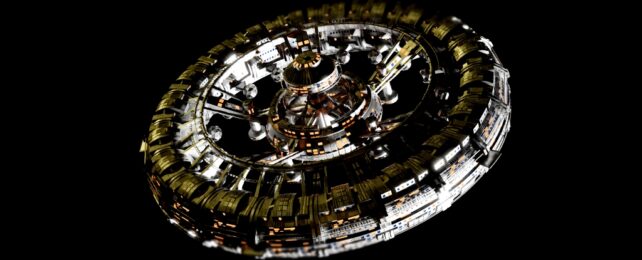The basic idea of turning an asteroid into a rotating space habitat has existed for a while. Despite that, it's always seemed relatively far off regarding technologies, so the concept hasn't received much attention over the years.
But, if you're retired and have an underlying interest in researching space habitats, developing a detailed plan for turning an asteroid into one seems like a great use of time.
And that is precisely what David W. Jensen, a retired Technical Fellow at Rockwell Collins, recently did. He released a 65-page paper that details an easy-to-understand, relatively inexpensive, and feasible plan to turn an asteroid into a space habitat.
Fully diving into the report's details would be far beyond the scope of this article, but we can hit the highlights. Dr. Jensen breaks the discussion into three main categories – asteroid selection, habitat style selection, and mission strategy to get there (i.e., what robots to use). Let's tackle each of them in turn.

Asteroid selection focused on which asteroid would make the best candidate to be transformed into a rotating space habitat. Considerations for this part include what the asteroid is made of, its proximity to Earth (and "delta-V," i.e., how much energy it takes to reach), and its overall size.
After a relatively in-depth selection process, Dr. Jensen decided on one in particular as a good candidate – Atira. This S-type asteroid has an entire class of asteroids named after it. Atira comes in at about a 4.8 km diameter and even has its own moon – a 1 km diameter asteroid that orbits it closely.
It wasn't the closest potential asteroid, with its closest approach at about 80 times the distance to the Moon. Still, its orbit is stable in the "Goldilocks zone" of our solar system, which would help stabilize the internal temperature of the habitat it would eventually be turned into.
So what type of habitat should it be turned into? Dr. Jensen looked at four common types – the "dumbbell," sphere, cylinder, and torus. One of the most critical considerations is gravity – or "artificial gravity"- caused by centripetal force. Dr. Jensen mentions the detrimental effects of living in low-gravity situations for long periods, which necessitates using some artificial replacement for it.
But to get centripetal force, the station has to rotate. Atira already has a slight rotation, but part of creating a space habitat would include spinning the asteroid itself up to a reasonable rotational speed that could accurately mimic the gravity a person would feel on Earth.
Dr. Jensen also goes through numerous other considerations for the selection of a specific type of station, including the forces it would create on the material it was made out of (he suggests using anhydrous glass as a potential structural element), how much material needs to be on the outer shell to protection from radiation and micrometeorites, and how much living area would be contained inside.
For that last consideration, he suggests adding multiple floors to the structure, dramatically increasing overall living space throughout the habitat.
He eventually settled on a torus as the ideal habitat type and then dives into calculations about the overall station mass, how to support the inner wall with massive columns, and how to allocate floor space. All important, but how exactly would we build such a massive behemoth?
Self-replicating robots are Dr. Jensen's answer. The report's third section details a plan to utilize spider robots and a base station that can replicate themselves. He stresses the importance of only sending the most advanced technical components from Earth and using materials on the asteroid itself to build everything else, from rock grinders to solar panels.
Theoretically, it seems coherent and makes sense, but when you look at the claims, that seems almost out of this world.
First, let's look at the overall weight – Dr. Jensen suggests you could send a "seed" capsule that contains four spider robots, the base station, and enough advanced electronics to build 3000 more spider robots for only around 8.6 metric tons – that's well less than the capacity of even a modern day Falcon Heavy. Once it reaches the asteroid, it won't need any further input from the Earth – in theory, at least.
Then, let's get to some even more impressive numbers – the cost and time. With admittedly "back-of-the-envelope" calculations, Dr. Jensen estimates that the program would cost only $4.1 billion. That is far less than the $93 billion NASA plans to spend on the Apollo program. And the result would be a space habitat that provides 1 billion square meters of land that didn't exist before. That's a total cost of $4.10 per square meter to build land – in space.
Possibly even more impressive is the timeline – Dr. Jensen estimates that the entire construction project could be done in as little as 12 years. However, it will still take longer to fill the habitat with air and water and start regulating its temperature. Still, that is a relatively short timeline for such an ambitious project.
These costs and timelines are also well within the personal wealth levels of billionaires that have already shown an interest in space exploration – here's looking at you, Jeff, and Elon.
If Dr. Jensen's ideas are even partially feasible, and on the surface, they certainly seem to be, with a bit more technical development, maybe the next big billionaire space competition would be to see who could build the world's first artificial gravity space habitat. That would be quite a sight to behold.
This article was originally published by Universe Today. Read the original article.
